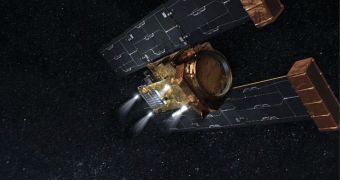After 12 years of activity, the most active comet-hunting spacecraft NASA ever operated, the Stardust probe, will finally end its activity with a scheduled engine firing called the “burn to depletion.” Even at it is retired from active duty the robotic explorer will provide the space agency with new information.
Though an engine firing may not seem like a big deal in this context, scientists at the American space agency say that the maneuver may provide them with unique insight into the accuracy of their models.
Stardust will carry out its final maneuver on Thursday, March 24, starting at 4 pm PDT (7 pm EDT, 2300 GMT). Its engines will be ignited for the last time, and will not be shut down until all fuel left in the tanks will be entirely depleted.
Collectively, the components of Stardust's propulsion system fired off more than 2 million times since the probe was launched in 1999 to visit comet Wild 2. Before arriving at its destination in 2004, it also did a flyby of comet Annefrank back in 2002.
Its primary mission ended in 2006, when a sample container carrying particles from Wild 2 reached Earth. But Stardust was not retired after that, but put in stand by for a while. It was reactivated last year, and carried out one final flyby, this time around comet Tempel 1, on February 14, 2011.
Now that even the last drop of functionality was extracted from the spacecraft, NASA is getting ready to shut it down for good. But even as this happens, sensors aboard the probe will provide critical data about computer models that the agency uses to calculate how much fuel to put on its space vehicles.
“We call it a 'burn to depletion,' and that is pretty much what we're doing – firing our rockets until there is nothing left in the tank. It's a unique way for an interplanetary spacecraft to go out. Essentially, Stardust will be providing us useful information to the very end,” says Tim Larson.
The expert holds an appointment as the Stardust-NExT project manager at the NASA Jet Propulsion Laboratory (JPL), in Pasadena, California. He says that the control team doesn't know how much fuel Stardust still has in its tanks. The final burn will reveal this information.
“We'll take those data and compare them to what our estimates told us was left, That will give us a better idea how valid our fuel consumption models are and make our predictions even more accurate for future missions,” adds Allan Cheuvront.
He is the program manager for Stardust-NExT at Lockheed Martin Space Systems, the main contractor NASA used to build the spacecraft. The expert says that Stardust is now some 312 million kilometers (194 million miles) away from its home.
“When we take into account all the possibilities for how long the burn could be and then the possible post-burn trajectories, we project that over the next 100 years, Stardust will not get any closer than 1.7 million miles of Earth's orbit, or within 13 million miles of Mars orbit,” Larson adds.
“That is far enough from protected targets to meet all of NASA's Planetary Protection directives,” he concludes.

 14 DAY TRIAL //
14 DAY TRIAL //